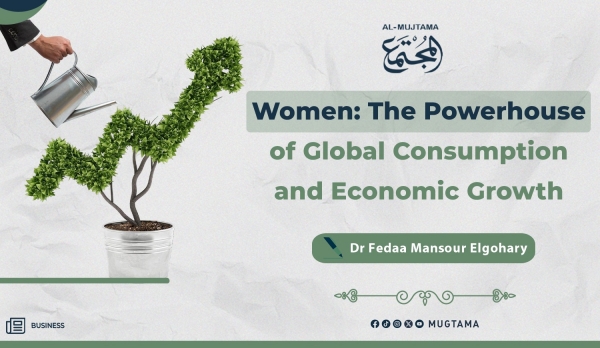The Rise of the Women’s Economy: Shaping Markets and Driving Change Featured
Women are the backbone of conscious consumption and the engine of the global economy. Women have long been responsible for household decisions. According to statistics, women influence and control 85% of consumer spending globally (a very high number). Consequently, the rise of the "women's economy" is inevitable. Therefore, companies that recognize and focus on female consumers and their purchasing power, estimated at around USD 31.7 trillion, have the potential to connect their businesses to this formidable force and reach new horizons. Companies that do not do so risk falling behind.
Today's statistics show a profound impact of women in markets valued at trillions of dollars. Studies have shown that women influence and control important purchasing decisions, including (1):
- 91% of home purchases.
- 92% of vacations.
- 80% of healthcare.
- 93% of food and over-the-counter medications.
- 65% of new cars.
- 89% of bank accounts.
Women now hold the largest share of global purchasing power, and the economic influence of women in the consumer market is increasing. Women are expected to control about 75% of spending worldwide by 2028 (2).
It is not only the purchasing power of women that is increasing, but we are also witnessing a rise in the labor force, with women contributing to the labor market in more meaningful ways than ever before. The more women who work, the more economies grow.
Estimates indicate that closing the gender gap could boost the global economy by USD 7 trillion. Moreover, closing the gender gap in employment could increase per capita GDP in the long term by an average of about 20% across different countries.
This is even though one in ten women lives in extreme poverty. If current trends continue, it is expected that by 2030, 8% of the world's population of women (approximately 342.4 million women and girls) will live on less than USD 2.15 per day, with most of them (around 220.9 million) living in sub-Saharan Africa (3).
Studies have shown that raising the educational attainment of women and girls contributes to their economic empowerment and achieves more inclusive and environmentally sustainable economic growth. Education, skills development, and retraining (especially to keep pace with rapid technological changes affecting jobs) are crucial for raising awareness and making informed consumer decisions, as well as increasing their opportunities for income generation and participation in the formal labor market.
Educated women tend to be more knowledgeable about nutrition and healthcare and have healthier children. The United Nations estimates that for each additional year of a mother's education, the probability of infant mortality decreases by 5-10%.
Research also indicates that women are more likely to engage in sustainable consumption practices compared to men because they are often more socially responsible and environmentally conscious. They spend more time researching information about sustainable consumption and sustainable alternatives compared to men, leading to positive changes in their consumption behavior and priorities.
Therefore, encouraging fair economic inclusion between men and women and achieving economic empowerment strengthens societies and drives them towards enhancing resilience to shocks. Women's economic empowerment is achieved by ensuring their equal participation in and benefit from decent work and social protection, access to markets and control over their resources and time, and enhancing their ability to make economic decisions and their active participation in economic decision-making at all levels, from the family to international institutions.
Initiatives to support women in the Arab world have witnessed remarkable progress, with increasing initiatives to support Arab women economically, such as funding programs for female entrepreneurs and initiatives that support equal pay and work in the private sector. For example:
- Bahrain launched the National Strategy for the Advancement of Bahraini Women in 2024, aiming to achieve gender equality and balance, in addition to consolidating the principles of women's empowerment, enhancing their social role, and expanding their contribution to entrepreneurship, especially among young women.
- The UAE hosted the Global Women's Forum 2024 in Dubai, under the theme "The Power of Influence. " The forum focused on women's role in achieving the Sustainable Development Goals, their economic empowerment, and the promotion of gender equality.
- Kuwait organized a regional conference entitled "Arab Women, Peace and Security... Challenges Facing Women in the Arab Region," aimed at combating violence against women and children in armed conflict, with a focus on the suffering of women in the Gaza Strip.
- Saudi Arabia has enhanced the role of women through the enactment of new empowerment laws and policies within its Vision 2030, working to increase women's participation in the labor market, in addition to launching programs to support entrepreneurship and provide educational and professional opportunities for women in the Kingdom (4).
- Egypt has also formulated the National Strategy for the Empowerment of Egyptian Women 2030. The strategy seeks to achieve women's economic empowerment by developing their capabilities to expand available work options, increase their participation in the labor force, and achieve equal opportunities in women's employment in all sectors while preventing practices that perpetuate discrimination against women or harm them.
Although women are consumers by nature, today's women are educated and conscious consumers who gather information and make informed decisions about their purchases and consumption, shaping more informed, responsible, and sustainable consumption patterns, not only at the individual and family level but also at the community level as a whole.
_________________________
(1) Marlowe, Tracy. (2024). The She-economy’s Rise: Women as Key Drivers of Economic Growth, Diversity & Inclusion in Business, November 12, 2024. At: https://eonetwork.org/blog/sheconomy-rise-of-women-as-key-drivers-of-economic-growth/
(2) Carter, Sandy. (2024) Who Runs the World? Women Control 85% Of Purchases, 29% Of STEM Roles, FORBES DIGITAL ASSETS, Mar 07, 2024 At: https://www.forbes.com/sites/digital-assets/2024/03/07/who-runs-the-world-women-control-85-of-purchases-29-of-stem-roles/?sh=27ecccec15d8
(3) UN Women, Facts and figures_ Economic empowerment _ UN Women – Headquarters, (February 2024). Available at: https://www.unwomen.org/en/what-we-do/economic-empowerment/facts-and-figures
(4) فهمي فيولا. (2024). "رغم الحروب والتحديات.. عام 2024 يشهد تقدماً ملموساً في دعم وتمكين المرأة العربية"، ديسمبر 2024، متاح على:
https://jusoorpost.com/ar/posts/50259/rghm-alhrob-oalthdyat-aaam-2024-yshhd-tkdma-mlmosa-fy-daam-otmkyn-almra-alaarby
